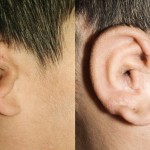 Being able to practice on as life-like an organ as possible has obvious benefits to surgeons looking to learn their craft. I wrote recently about a startup called EchoPixel that are turning to 3D printing to quickly and accurately create replicas of the organ about to be operated on so that surgeons can practice before going about their work on the real thing.
Being able to practice on as life-like an organ as possible has obvious benefits to surgeons looking to learn their craft. I wrote recently about a startup called EchoPixel that are turning to 3D printing to quickly and accurately create replicas of the organ about to be operated on so that surgeons can practice before going about their work on the real thing.
Now, researchers at the University of Washington believe that a similar approach could also prove invaluable for children born without an ear.
Creating new ears
Traditionally when surgeons were called upon to perform such a task, they would practice on things such as an apple or bar of soap. Suffice to say however, this doesn’t really replicate the experience of crafting a new ear out of rib cartilage.
The researchers have used 3D printing to create a low cost rib cartilage model that they believe accurately resembles the feel of the real thing to therefore allow surgeons to hone their craft.
“It’s a huge advantage over what we’re using today,” the researchers say.
“You literally take a bar of Lever 2000 while the attending is operating and you carve ear cartilage. It does teach you how to get the shape right, but the properties are not super accurate—you can’t bend it, and sewing it is not very lifelike.”
The 3D printed ears were created using a CT scan from an 8 year old patient. The creation was compared to both ears made from rib cartilage and from dental impression material, with surgeons uniformly preferring the new models.
Shorter lead times
In addition to producing a higher quality product, the process is also significantly faster than existing methods. There is typically a six to 12 month waiting list for a new ear, with the lack of skills a major factor in that.
“It’s a surgery that more people could do, but this is often the single biggest roadblock,” the authors say. “They’re hesitant to start because they’ve never carved an ear before. As many potatoes and apples as I’ve carved, it’s still not the same.”
The new ears are also much more lifelike as they are a perfect replica of the patients ear. With each patient having a unique anatomy, this allows a perfect training opportunity.
The next step is to take the process out of the laboratory and into the hands of surgeons, both in the field and in training to see how they perform out in the wild.
“With one 3D-printed mold, you can make a billion of these models for next to nothing,” the team conclude. “What this research shows is that we can move forward with one of these models and start using it.”
Fascinating stuff.
This is excellent stuff and must be so very useful for the medical industry.
3D printers are revolutionizing many technologies and even education itself. In a similar manner to that described in this article, other surgeons have obtained a replica of a tumor of difficult access, using computed tomography to create the 3D model of the tumor that was sent to the 3D printer to reproduce it physically. This physical model allowed the surgeons to study the difficulties and repeatedly train the operation. It also allowed to teach students the difficulties of surgery and operation strategy.